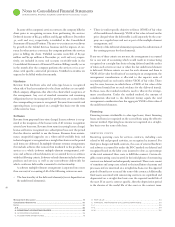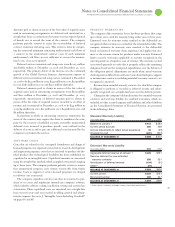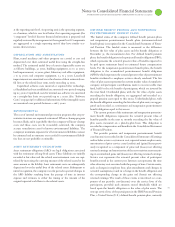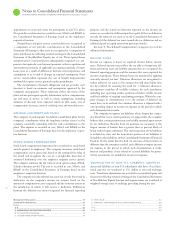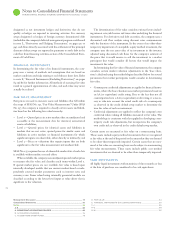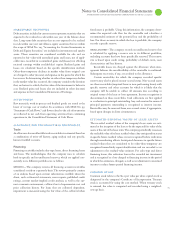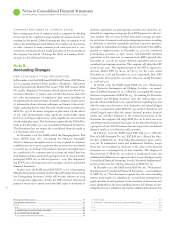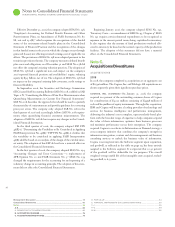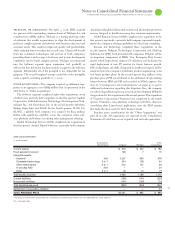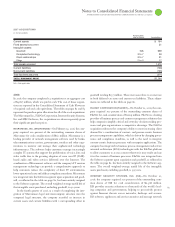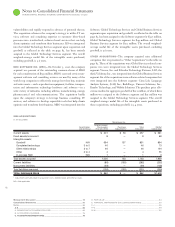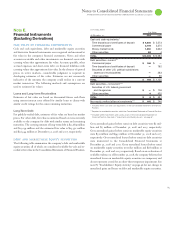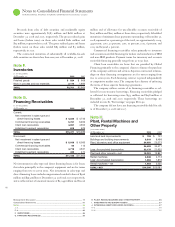IBM 2008 Annual Report Download - page 80
Download and view the complete annual report
Please find page 80 of the 2008 IBM annual report below. You can navigate through the pages in the report by either clicking on the pages listed below, or by using the keyword search tool below to find specific information within the annual report.
Notes to Consolidated Financial Statements
INTERNATIONAL BUSINESS MACHINES CORPORATION and Subsidiary Companies
Management Discussion ............................................................................................. 18
Consolidated Statements ............................................................................................ 60
Notes ............................................................................................................................... 66
A – E ........................................................................................................................66
A. SIGNIFICANT ACCOUNTING POLICIES ...........................................................66
B. ACCOUNTING CHANGES ................................................................................76
C. ACQUISITIONS/DIVESTITURES .......................................................................78
D. FAIR VALUE ......................................................................................................84
E. FINANCIAL INSTRUMENTS (EXCLUDING DERIVATIVES) .................................85
F – J ........................................................................................................................86
K– Q .......................................................................................................................88
R –W ..................................................................................................................... 10 2
Effective December , , the company adopted SFAS No. ,
“Employer’s Accounting for Defined Benefit Pension and Other
Postretirement Plans, an Amendment of FASB Statements No. ,
, and (R),” which requires the recognition of the funded
status of the retirement-related benefit plans in the Consolidated
Statement of Financial Position and the recognition of the changes
in that funded status in the year in which the changes occur through
gains and
(l
osses) not affecting retained earnings, net of applicable tax
effects. The provisions of SFAS No. were adopted pursuant to the
transition provisions therein. The company measures defined benefit
plan assets and obligations as of December and SFAS No. did
not affect the company’s existing valuation practices. The adoption of
SFAS No. had a significant non-cash impact on the company’s
reported financial position and stockholders’ equity, reducing
equity by $. billion, net of tax. The adoption of SFAS No. had
no impact on the company’s existing debt covenants, credit ratings or
financial flexibility.
In September , the Securities and Exchange Commission
(SEC) issued Staff Accounting Bulletin (SAB) No. , codified as SAB
Topic .N, “Considering the Effects of Prior Year Misstatements when
Quantifying Misstatements in Current Year Financial Statements.”
SAB No. describes the approach that should be used to quantify
the materiality of a misstatement and provides guidance for correcting
prior-year errors. The company early adopted SAB No. in the
third quarter of and accordingly, follows SAB No. require-
ments when quantifying financial statement misstatements. The
adoption of SAB No. did not require any changes to the Consol-
idated Financial Statements.
In the third quarter of , the company adopted FSP FIN
(R)-, “Determining the Variability to Be Considered in Applying
FASB Interpretation No. (R).” FSP FIN No. (R)- clarifies that
the variability to be considered in applying FASB Interpretation
(R) shall be based on an analysis of the design of the variable inter-
est entity. The adoption of this FSP did not have a material effect on
the Consolidated Financial Statements.
In the first quarter of , the company adopted SFAS No. ,
“Accounting Changes and Error Corrections — a replacement of
APB Opinion No. and FASB Statement No. .” SFAS No.
changed the requirements for the accounting for and reporting of a
voluntary change in accounting principle. The adoption of this state-
ment did not affect the Consolidated Financial Statements.
Beginning January , the company adopted SFAS No. ,
“Inventory Costs — an amendment of ARB No. , Chapter .” SFAS
No. requires certain abnormal expenditures to be recognized as
expenses in the current period versus being capitalized in inventory.
It also requires that the amount of fixed production overhead allo-
cated to inventory be based on the normal capacity of the production
facilities. The adoption of this statement did not have a material
effect on the Consolidated Financial Statements.
Note C.
Acquisitions/Divestitures
2008
In , the company completed acquisitions at an aggregate cost
of $, million. The Cognos, Inc. and Telelogic AB acquisitions are
shown separately given their significant purchase prices.
COGNOS, INC. (COGNOS)—On January , , the company
ac quired percent of the outstanding common shares of Cognos
for consideration of $, million consisting of $, million of
cash and $ million of equity instruments. Through this acquisition,
IBM and Cognos will become a leading provider of technology and
services for business intelligence and performance management,
delivering the industry’s most complete, open standards-based plat-
form with the broadest range of expertise to help companies expand
the value of their information, optimize their business processes
and maximize performance across their enterprises. The company
acquired Cognos to accelerate its Information on Demand strategy, a
cross-company initiative that combines the company’s strength in
information integration, content and data management and business
consulting services to unlock the business value of information.
Cognos was integrated into the Software segment upon acquisition,
and goodwill, as reflected in the table on page , has been entirely
assigned to the Software segment. It is expected that - percent
of the goodwill will be deductible for tax purposes. The overall
weighted-average useful life of the intangible assets acquired, exclud-
ing goodwill, is . years.


